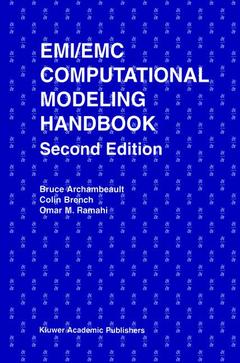EMI/EMC Computational Modeling Handbook (2nd Ed., Softcover reprint of the original 2nd ed. 2001) The Springer International Series in Engineering and Computer Science Series, Vol. 630
Langue : Anglais
Auteurs : Archambeault Bruce R., Ramahi Omar M., Brench Colin

The application of computational electromagnetics to real-world EMI/EMC engineering is an emerging technology. With the advancement in electronics, EMI/EMC issues have greatly increased in complexity. As a result, it is no longer possible to rely exclusively on traditional techniques and expect cost-effective solutions. The first edition of this book introduced computational electromagnetics to EMI/EMC engineering. This second edition continues the introduction of computational electromagnetics to EMI/EMC engineering, but also adds new modeling techniques, namely the Partial Element Equivalent Circuit method and the Transmission Line Matrix method, and updates to the science of EMI/EMC modeling that have occurred since the first edition was published.
This book combines the essential elements of electromagnetic theory, computational techniques, and EMI/EMC engineering as they apply to computational modeling for EMI/EMC applications. It is intended to provide an understanding for those interested in incorporating modeling techniques in their work. A variety of modeling techniques are needed for anyone interested in using computational modeling in the real world. This book includes an introduction of all the popular modeling techniques, such as the Finite-Difference Time-Domain method, the Method of Moments, the Finite Element Method, the Partial Element Equivalent Circuit method and the Transmission Line Matrix method.
EMI/EMC Computational Modeling Handbook, Second Edition will serve many different levels of readers. It will serve as a basic introduction to modeling as applied to EMI/EMC problems for the engineer interested in getting started, and it will help the person already using modeling as a tool to become more effective in using different modeling techniques. It will also be useful for the engineer who is familiar with computational techniques and wishes to apply them to EMI/EMC applications. This book can also be used as a text to help students of electromagnetic theory and application better understand real-world challenges facing engineers.
This book combines the essential elements of electromagnetic theory, computational techniques, and EMI/EMC engineering as they apply to computational modeling for EMI/EMC applications. It is intended to provide an understanding for those interested in incorporating modeling techniques in their work. A variety of modeling techniques are needed for anyone interested in using computational modeling in the real world. This book includes an introduction of all the popular modeling techniques, such as the Finite-Difference Time-Domain method, the Method of Moments, the Finite Element Method, the Partial Element Equivalent Circuit method and the Transmission Line Matrix method.
EMI/EMC Computational Modeling Handbook, Second Edition will serve many different levels of readers. It will serve as a basic introduction to modeling as applied to EMI/EMC problems for the engineer interested in getting started, and it will help the person already using modeling as a tool to become more effective in using different modeling techniques. It will also be useful for the engineer who is familiar with computational techniques and wishes to apply them to EMI/EMC applications. This book can also be used as a text to help students of electromagnetic theory and application better understand real-world challenges facing engineers.
1 Introduction.- 1.1 Introduction to EMI/EMC.- 1.2 Why Is EMI/EMC Modeling Important?.- 1.3 State of the Art of EMI/EMC Modeling.- 1.4 Tool Box Approach.- 1.5 Brief Description of EMI Modeling Techniques.- 1.6 Other Uses for Electromagnetic Modeling.- 1.7 Summary.- 2 Electromagnetic Theory and Modeling.- 2.1 Introduction.- 2.2 Time-Varying Maxwell’s Equations.- 2.3 Field Solution using Potentials.- 2.4 Maxwell’s Equations in the Frequency Domain.- 2.5 Electromagnetic Fields in Two-Dimensional Space.- 2.6 Numerical Modeling.- 2.7 Electromagnetic Modeling.- 2.8 Summary.- 3 The Finite-Difference Time Domain Method.- 3.1 Introduction.- 3.2 Two-Dimensional FDTD.- 3.3 Three-Dimensional FDTD.- 3.4 Modeling Primary Radiation Sources.- 3.5 Numerical Dispersion and Anisotropy.- 3.6 Mesh Truncation Techniques.- 3.7 Field Extension.- 3.8 FDTD Simulation Errors.- 4 Method of Moments.- 4.1 Introduction.- 4.2 Linear Operators.- 4.3 Pocklington Integral Equation.- 4.4 Method of Moments Development.- 4.5 Summary.- 5 The Finite Element Method.- 5.1 Introduction.- 5.2 Variational Forms.- 5.3 Construction of Finite Elements.- 5.4 Solving the Two-Dimensional Helmholz Equation.- 5.5 Numerical Considerations.- 5.6 Summary.- 6 Preparation for Modeling.- 6.1 The EMI/EMC Problem.- 6.2 Overview of Modeling Options.- 6.3 Selecting a Computational Technique.- 6.4 Elements of an EMI/EMC Model.- 6.5 Model Goals.- 6.6 How to Approach EMI/EMC Modeling.- 6.7 Summary.- 7 Creating EMI/EMC Models.- 7.1 Introduction.- 7.2 Creating Practical Models.- 7.3 Modeling Electromagnetic Radiators.- 7.4 Modeling a Shield with Apertures.- 7.5 Summary.- 8 Special Topics in EMI/EMC Modeling.- 8.1 Introduction.- 8.2 Multistage Modeling.- 8.3 Designing EMI/EMC Filters.- 8.4 Intermediate Model Results.- 8.5 EMI/EMCTest Sites.- 8.6 Antennas.- 8.7 Summary.- 9 Model Validation.- 9.1 Introduction.- 9.2 Validation of Computational Technique.- 9.3 Validation of Software Code Implementation.- 9.4 Validation Using Measurements.- 9.5 Validation Using Intermediate Results.- 9.6 Summary.- 10 Standard EMI/EMC Problems for Software Evaluation.- 10.1 Introduction.- 10.2 General Principles.- 10.3 Generalized Modeling Problems.- 10.4 Standard Problems.- 10.5 Summary.- 11 Advanced Modeling Techniques.- 11.1 Introduction.- 11.2 PEEC Model for PC Board Analysis.- 11.3 The Transmission Line Method.- 11.4 Summary.
Date de parution : 10-2012
Ouvrage de 315 p.
15.5x23.5 cm
Date de parution : 08-2001
Ouvrage de 315 p.
15.5x23.5 cm
Thème d’EMI/EMC Computational Modeling Handbook :
Mots-clés :
Software; Standard; Transmission; complexity; electronics; model; modeling
© 2024 LAVOISIER S.A.S.


